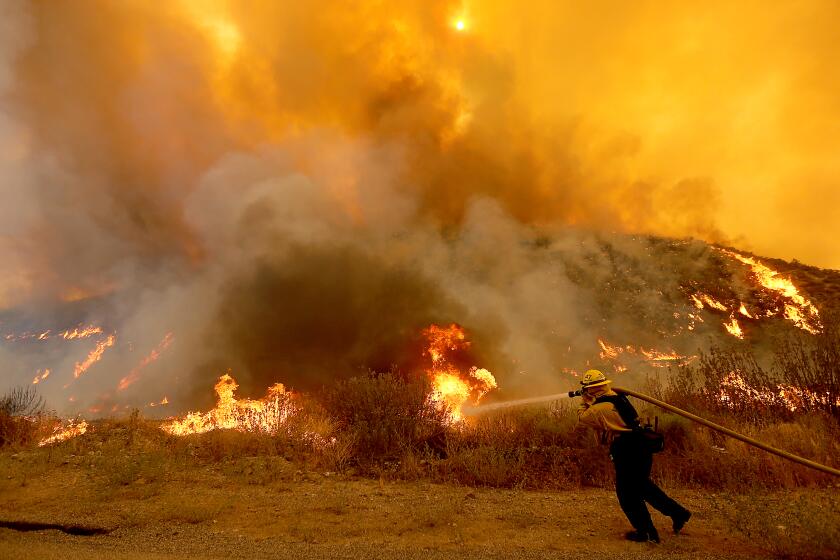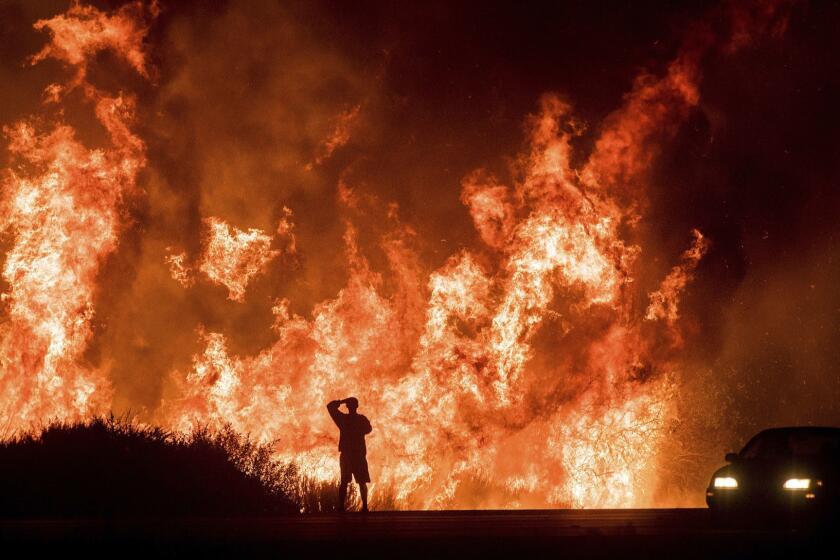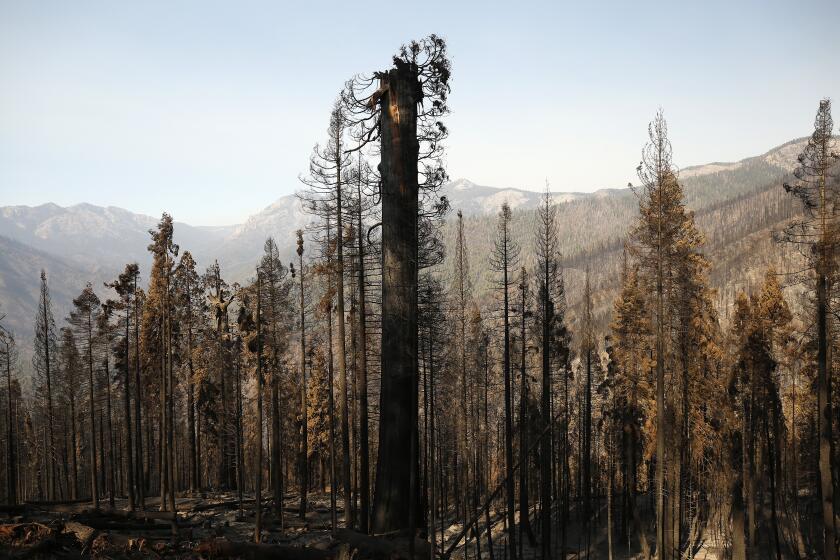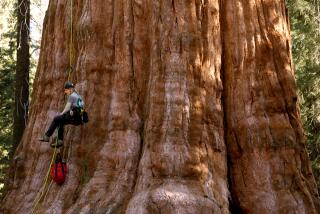We’ve got it all wrong about sequoias and wildfire
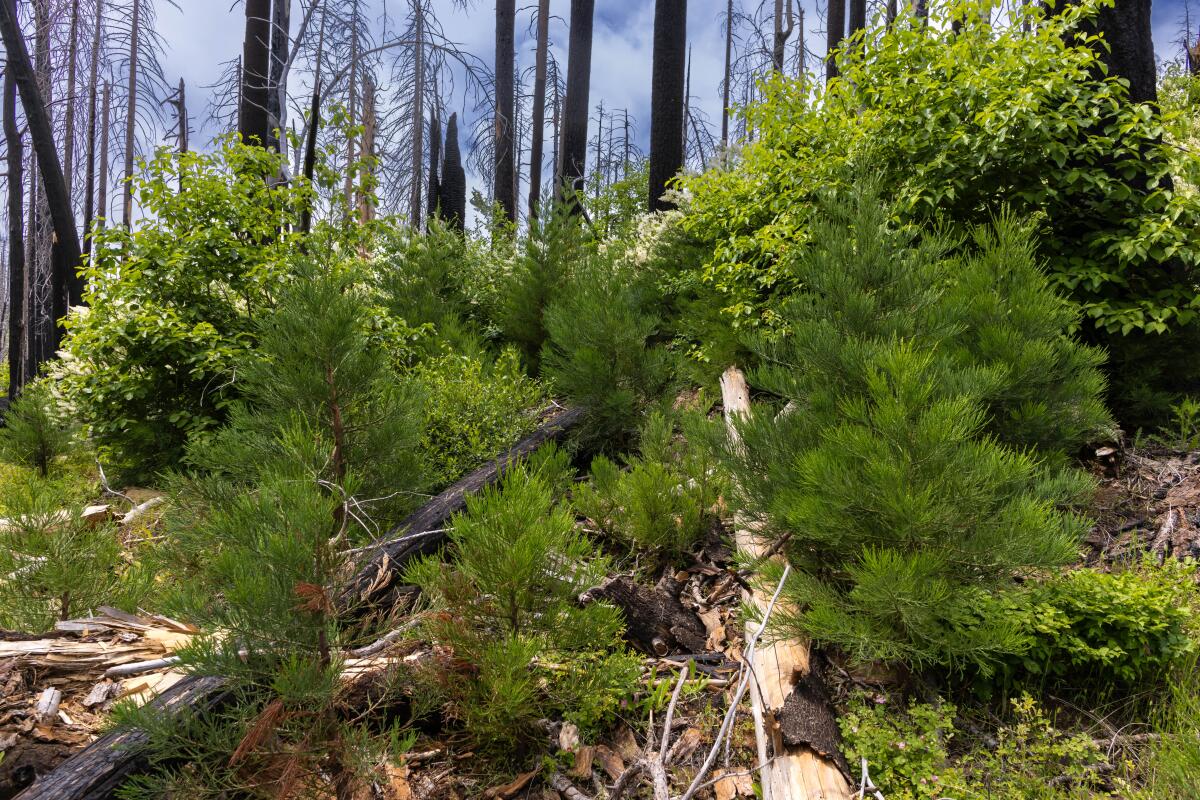
- Share via
As my colleagues and I hiked through the Nelder giant sequoia grove south of Yosemite National Park recently, we could barely believe our eyes. In 2017, the Railroad fire swept through nearly all of the Nelder Grove, burning lightly in most areas but very intensely in the portion where we walked, about six years after the fire. The naturally regenerating giant sequoia forest was so vigorous and lush that, in many places, we had to pull the stems of young sequoias apart just so we could walk between them. There were hundreds of them on almost every acre — many of them already 8 or 9 feet tall.
It was a remarkable sight because, in that particular location, the Railroad fire burned hot, killing trees, including about three dozen mature sequoias. This high-intensity fire patch is isolated; it’s nearly half a mile from the grove’s nearest remaining live, mature sequoias. How was the extraordinary rejuvenation of giant sequoias possible there?
Between 1996 and 2020, wildfire burn areas in California grew five times larger than in the 25 years prior. Scientists say climate change is to blame.
The U.S. Forest Service, which manages the Nelder Grove and many other sequoia groves, has repeatedly told the public, the media and Congress that giant sequoias are adapted to mild and moderate surface fires. The agency has insisted that emergency actions in sequoia groves are necessary to save the trees from high-intensity fire and ensure that only lower-intensity fire occurs. Those emergency actions could take the form of bulldozers, chain saws and logging, without benefit of the usual environmental safeguards, if pending legislation — the deceptively named Save Our Sequoias Act, introduced by House Speaker Kevin McCarthy (R-Bakersfield) — passes in Congress. Meanwhile, the Forest Service is already moving forward with logging plans in the Nelder Grove, based on this “emergency” posture.
But the evidence on the ground in the Nelder Grove and other burn areas contradicts the narrative that lower-intensity fire is the only good fire. Is it possible that we’ve got it all wrong when it comes to giant sequoias and wildfires?
As it happens, some of the U.S. Forest Service’s own scientific studies already explored that question years ago, indicating that mixed-intensity fire, not logging, is the solution for giant sequoias. However, for an agency that is still focused on selling public trees to private logging companies and keeping the revenue for its budget, that can be an inconvenient answer.
Responding to the tragic losses of homes and lives in wildland fires in California over the past year, Gov.
In 1994, for example, the Forest Service issued a study finding that the agency’s successful elimination of wildfires for more than a century was actually killing the sequoia groves and threatening their survival. The old “monarch” sequoias were slowly dying off, and new sequoia seedlings and saplings were almost completely absent, resulting in a “massive failure of sequoia reproduction.” The study found that, in order to maintain stable or increasing populations, giant sequoias depend specifically on high-intensity fire in patches, noting that the “giant sequoia is what is known as a ‘pioneer species,’ requiring canopy-destroying disturbance to complete its life cycle.”
These pockets of intense wildfire melt the resins in sequoia cones, allowing them to release seeds by the tens of thousands, while also creating more sunlight for the seedlings and consuming the thick layer of twigs and needles on the forest floor, turning it into a nutrient-rich bed of ash that helps young sequoias grow and thrive. Twelve years ago, another Forest Service study found a distinct lack of sequoia reproduction in low-intensity fire areas and a high density of reproduction in high-intensity fire patches. Managing for homogenous low-intensity fire, and attempting to prevent and exclude higher-intensity fire, is like managing for the extinction of giant sequoias.
When the Washburn fire burned part of the famed Mariposa sequoia grove in Yosemite last year, it burned at low intensity where the park had previously conducted prescribed burns. Park officials claimed success, based on the assumption that reducing fire intensity is categorically a good thing for giant sequoias. But the science has been telling us a more complex story for decades.
In 2020-2021, 1 in 5 elders of the planet’s superlative plant, a supremely fire-resistant species, went up in flames.
Of course, sequoias can’t tolerate only high-intensity fire either. We want a mix of low, moderate and high, and that is what we have been getting in the Sierra. Despite reports of utter decimation by high-intensity fire, my research, based on recent satellite imagery and ground surveys, indicates that the big 2020-through-2021 wildfires have killed about 8% of the sequoias, not up to 20%, as some have claimed.
A loss of 8% sounds bad in itself, but it may be in line with what could have occurred naturally before 20th century fire exclusion. And as in the Nelder Grove, where some patches of mature giant sequoia are torched by high-intensity fires, there will likely be hundreds of saplings for every one killed.
If we truly care about giant sequoia forests, the path forward should not involve mandated emergency powers that circumvent environmental laws and public participation, powers that could unleash potentially destructive logging. The Save Our Sequoias Act is wrong-headed, which is why it is strongly opposed by more than 80 environmental organizations.
No, to have healthy, vibrant giant sequoia forests in the future, we need some humility and some respect for a species that has evolved an interdependent relationship with mixed-intensity wildfires over the course of 90 million years. Above all, we will need to begin to appreciate and accept the dynamic forces of wild nature, like wildfires, that may seem alarming to us, but which also shape and nurture giant sequoia forests and many other fire-adapted ecosystems on the planet.
We must learn to see the beauty in the burn.
Chad Hanson is an ecologist and the director of the John Muir Project. He is the author of “Smokescreen: Debunking Wildfire Myths to Save Our Forests and Our Climate.”
More to Read
A cure for the common opinion
Get thought-provoking perspectives with our weekly newsletter.
You may occasionally receive promotional content from the Los Angeles Times.
